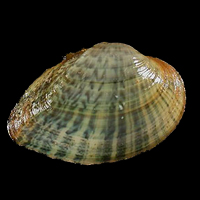Fawnsfoot
Scientific name: Truncilla donaciformis

Cover photo credit: Karen Little
Status
Endangered
Endangered
means the species lives in the wild in Ontario but is facing imminent extinction or extirpation.
Date added to the Species at Risk in Ontario List
September 10, 2009
What it looks like
The Fawnsfoot is a small, 35 to 45-millimetre long freshwater mussel.
Its yellowish to greenish-brown shell is smooth with dark green rays broken into v-shaped markings called chevrons.
Although the time for a Fawnsfoot to grow to maturity is unknown, the average age of maturity for similar species is 6-12 years.
Where it lives
The Fawnsfoot inhabits medium and large rivers with moderate to slow flowing water.
It usually inhabits shallow waters (one to five metres deep) with gravel, sand or muddy bottoms.
Where it’s been found in Ontario
Fawnsfoot is only found in North America, where it primarily occurs in the Great Lakes and Mississippi drainages.
In Canada, this species is limited to tributaries of the Great Lakes. In most areas where Fawnsfoot occurs, it has a patchy distribution and is limited to the lower portions of large rivers.
What threatens it
The introduction and spread of invasive mussels has caused major changes to Fawnsfoot habitat, resulting in the species’ decline.
Invasive mussels compete for habitat and interfere with native mussels’ feeding, respiration, locomotion and reproduction.
Declining water quality in the upper portions of watersheds likely has negative effects on the species.
Action we are taking
Endangered Species and their general habitat are automatically protected under Ontario’s Endangered Species Act, 2007.
Recovery strategy
A recovery strategy advises the ministry on ways to ensure healthy numbers of the species return to Ontario.
Read the executive summary and the full document (January 25, 2023)
Government response statement
A government response statement outlines the actions the government intends to take or support to help recover the species.
Read the government response statement (October 25, 2023)
Habitat protection
General Habitat Protection - September 10, 2009
What you can do
Report a Sighting
- Report a sighting of an endangered animal or plant to the Natural Heritage Information Centre. Photographs with specific locations or mapping coordinates are always helpful.
Volunteer
- Volunteer with your local nature club or provincial park to participate in surveys or stewardship work focused on species at risk.
Be a good steward
- Private land owners have a very important role to play in species recovery. If you find a Fawnsfoot in a watercourse on or adjacent to your property, you may be eligible for stewardship programs that support the protection and recovery of species at risk and their habitats.
- You can help improve mussel habitat and keep Ontario’s water safe and clean by maintaining natural vegetation next to creeks and rivers. The roots of plants reduce erosion and can stop soil from washing into the river. Fence off streamside areas to keep cattle (and their manure) out of the water. There are many other things that you can do to help reduce soil erosion and you might be eligible for funding assistance. For more information, visit the Ontario Soil and Crop Improvement Association.
Report illegal activity
- Report any illegal activity related to plants and wildlife to
1-866-MOETIPS (663-8477) (6638477 (663-8477)) .
Quick facts
- During their immature stage, Fawnsfoot are parasitic and attach themselves to the gills of a fish. They travel with their host, feeding on its body fluids until they develop into juveniles and release to carry out a free-living life cycle.